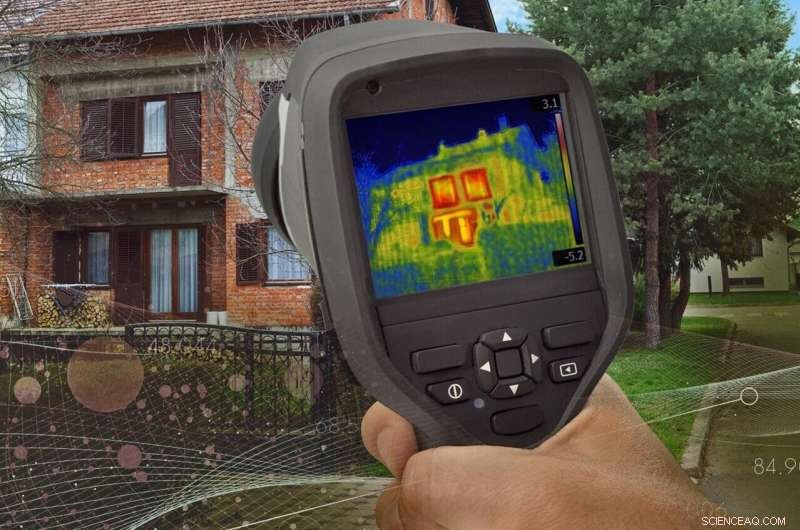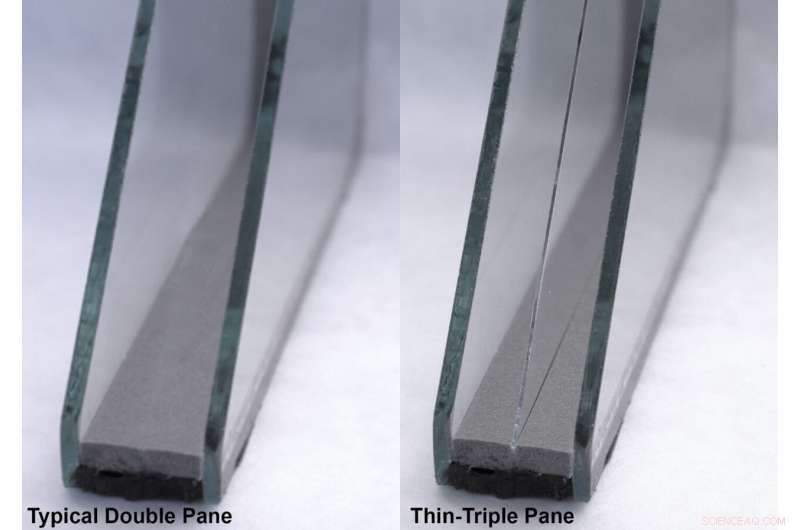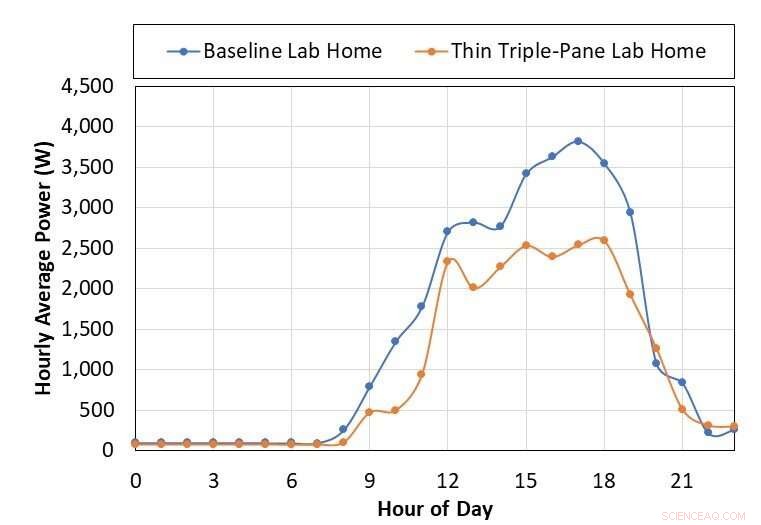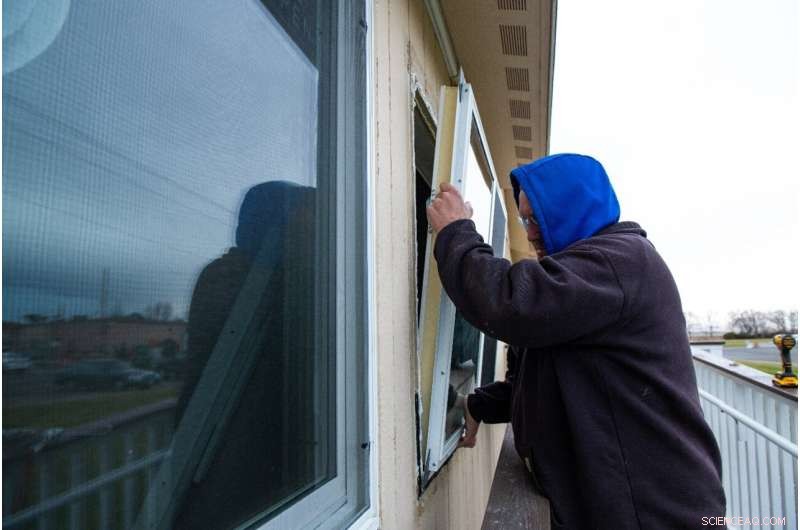
Infraröd (IR) bildteknik (visas här) är ett av verktygen som används för att mäta värmeförluster genom dåligt isolerade fönster. En serie forskningsstudier visar att en ny generation av treglasfönster kan bidra till att förbättra energieffektiviteten i hemmen. Kredit:Timothy Holland | Pacific Northwest National Laboratory
Det är dags att byta till fönster med tre fönster. Det är budskapet från en serie studier ledda av Department of Energy's Pacific Northwest National Laboratory i samarbete med en koalition av offentliga och privata partners.
"Lägre kostnader, större tillgänglighet och strävan att minska koldioxidutsläppen driver oss mot en tipppunkt där fönster med tre fönster börjar ge mycket ekonomisk betydelse", säger Kate Cort, forskningsekonom på PNNL och programchef för pågående fält. valideringsstudier av fönster med tre fönster.
Det är ingen hemlighet att ett hems fönster kan slösa mycket energi. De kan läcka luft, och även de senaste modellerna av dubbelglasfönster bidrar avsevärt till energianvändningen och kostnaden i ett hem. För ett nytt hem utgör fönster vanligtvis cirka 8 % av den yttre ytan men är ansvariga för hälften av värmeförlusten eller vinsten. Denna passiva energiförlust gör fönster till en stor bidragande faktor till kostnaderna för uppvärmning och kylning av hemmet.
Samtidigt har bevis för energi- och kostnadsbesparingar med treglasfönster sakta byggts upp i flera år, sedan de första prototyperna introducerades runt 1989. Tidigare studier har visat att treglasfönster är mer energieffektiva än industristandarden med dubbelglas. rutornas variation, men marknaden har gått långsamt på grund av kostnad och tillgänglighet.
Dessa nackdelar är på väg att förändras, sa Cort. En ny generation av tunna treglasfönster är billigare och kan lättare eftermonteras i befintliga dubbelglasramar. Som namnet antyder har treglasfönster tre glasrutor som skapar en dubbeldäckad sandwich, som fylls med en inert gas, såsom krypton, som ger ytterligare isoleringskraft. Dessa nästa generations fönster drar fördel av skalfördelar som tillhandahålls av samma avancerade glastillverkningsteknik som tar fram tunna men hållbara TV- och datorskärmar.
Under de senaste tre åren har Cort och hennes kollegor systematiskt utvärderat de energibesparingar och ekonomiska faktorer som kommer att avgöra hur snabbt de blir accepterade av byggare. Detta arbete stöddes av DOE Building Technologies Office och Bonneville Power Administration.
Nu börjar statliga tillsynsmyndigheter lägga märke till det. Nyligen använde delstaten Michigan data från en PNNL-fältstudie av fönster med tre fönster för att inkludera dem i delstatens tekniska resursmanual, lista över godkända energibesparande åtgärder som är berättigade till incitament och rabatter för allmännyttiga tjänster.
Nya energistandarder skapar brådska
En annan nyligen genomförd studie ledd av Cort, PNNL-kollegan Edward Louie och Robert Hart från Lawrence Berkeley National Laboratory visade att för nybyggnation av hem kan treglasfönster hjälpa byggare att till ett överkomligt pris uppfylla strängare energikoder 2021 för nya hem. Deras studie, publicerad i mars 2022 av ASHRAE Journal visade att när en husbyggare uppgraderar fönstren i ett nytt hem från dubbel till tre fönster kan fönstrens energieffektivitet förbättras med 40 % eller mer. Denna extra prestanda ökar det totala isoleringsvärdet för hela hemmets exteriör, ofta kallad byggnadsskalet.
"Vår studie visade att ökad energieffektivitet för fönster ger byggare mer flexibilitet i design och möjlighet att göra avvägningar med andra komponenter i kuvertet, såsom ytterväggsisolering, samtidigt som de uppfyller koden", säger Cort. Den övergripande effekten är att ge byggare fler alternativ och bättre försäkran om efterlevnad av byggnormer, samtidigt som komforten för husägare förbättras.

Thin triple-pane windows (right) have three panes of glass filled with an inert gas, krypton, and coated with a low-emission film to enhance energy efficiency. Credit:Lawrence Berkeley National Laboratory
What's the hold up for triple-pane windows?
Builders play a key role in the adoption of new home building technologies, said Cort. In 2020, she and her colleagues interviewed 29 home builders who have participated in the DOE Zero Energy Ready Home program. They asked builders to explain their decision-making process for window selection during the 2018 to 2019 building season. Forty-one percent of these builders used triple‐pane windows in all their new homes and another 28% in most or some of their homes. For those who didn't use triple-pane windows, the biggest factor was cost.
"The price differential between double-pane and triple-pane windows has been a pain-point for builders," Cort noted. But she added that the increased incremental material cost of triple-pane windows is now about $700 to $2,400 for a 2,400-square-foot wood-framed home. This is about the same cost as adding an extra inch of rigid wall insulation to the same home.
Some builders also stated that the indirect cost of custom installation for triple-pane windows, which can be 25% to 50% heavier than similar sized double‐pane windows, also weighed into their choice.
"Most builders aren't familiar with the newer thinner, lighter triple-pane technology," said Cort. But the survey showed most would be willing to try them if the cost and availability made it practical for them.

Thin triple-pane windows greatly reduced the power usage by the air-conditioning system in the hottest part of the day, compared with standard double-pane windows. The direct comparison was made in identical custom Lab Homes on the PNNL campus in summer 2020. Credit:Katherine Cort | Pacific Northwest National Laboratory
Some of the builders Cort's team interviewed noted that consumers like the comfort and quiet of triple-pane windows. A recent study confirmed that the installation of thin triple-panes reduced the sound infiltration by an average of 8-10 decibels when compared to the home with double-pane metal-frame windows, which roughly equates to reducing the perceived noise level by half.
"When someone comes into the house and you shut the door, it's like getting into a Mercedes or BMW," said a Seattle builder. "It's so solid and quiet. We are building homes next to Boeing Field airport in Seattle. Planes are flying right overhead so close you can clearly see them from the houses, and it is so quiet inside you can't hear them."
Demonstration projects lead the way
When there are new approaches to home building, said Cort, builders need assurances that materials will be available when needed, hold up under use, and deliver on promised improvements.
To help meet those expectations, PNNL has joined forces with DOE, Lawrence Berkley National Laboratory, and the Northwest Energy Efficiency Alliance to launch the Partnership for Advanced Window Solutions. With support from DOE, this public-private partnership is working with builders, utilities, and manufacturers to both drive demand and scale up production of cost-effective "drop-in" thin triple-pane window designs and other high-performance window solutions.

Installers insert thin triple-pane windows at a PNNL Lab Home, custom model homes on the PNNL campus built to conduct energy efficiency research. Kredit:Andrea Starr | Pacific Northwest National Laboratory
The PNNL team recently compared the energy efficiency performance of these windows in its Lab Homes, a pair of identical manufactured homes used to study energy efficiency. During the winter heating season of 2019 and the summer cooling season of 2020, researchers recorded energy usage and temperatures throughout the homes. During the two 10-week evaluation periods, the windows saved an average of 12% on heating and 28% on cooling for the 1,500-square-foot structures. In addition, the home with the triple-pane windows reduced outdoor noise and maintained much more comfortable and even temperatures throughout the home during both summer and winter testing periods.
The research team is now field testing the windows in 10 locations nationwide, from manufactured homes in Pasco, Wash., to a net-zero apartment complex in Rotterdam, N.Y. In these field demonstration projects, the incremental cost over standard ENERGY STAR windows was $6 per square foot or less, said Cort. Within the last year, multiple versions of the thin-glass triple-pane units have been developed, certified by the National Fenestration Rating Council, and have become available to builders.
"At this point, it's a matter of increasing awareness among manufacturers, builders, utility programs, and consumers," said Cort. "It's time to look at windows, not just through them."